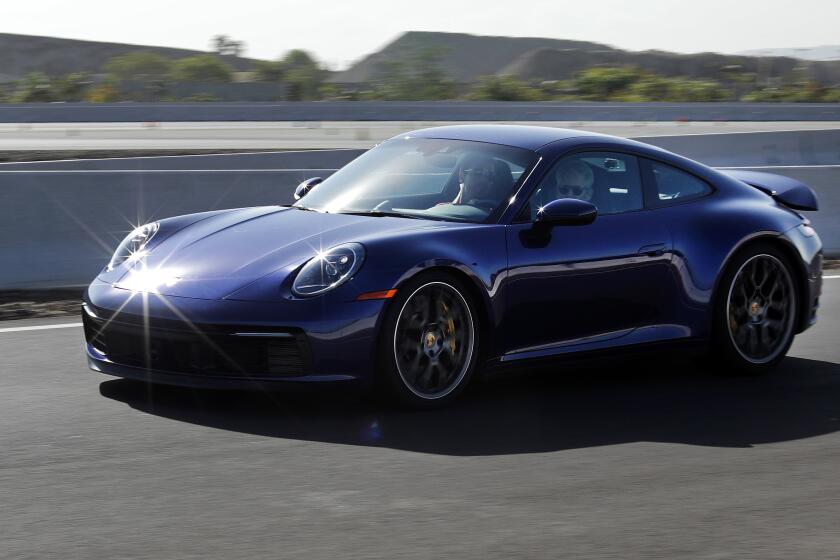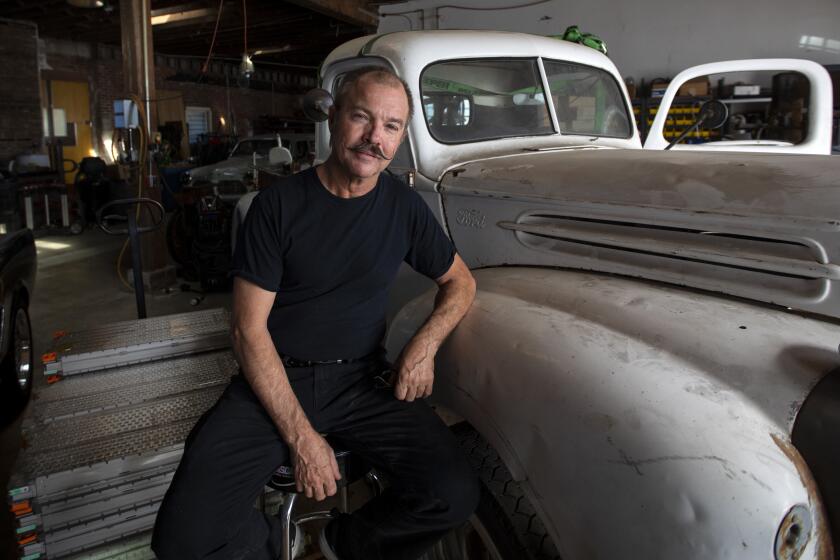Harley-Davidson and Zero launch new electric street bikes
- Share via
America’s largest motorcycle company and its most successful manufacturer of electric motorcycles are going head to head with a pair of battery-powered street bikes.
Harley-Davidson has begun selling its dynamic new LiveWire, the Milwaukee-based giant’s first battery bike, and the first in a coming line of many such two-wheelers.
Zero Motorcycles has started deliveries of the Zero SR/F, the fastest and most powerful electric machine yet from the 13-year-old Scotts Valley, Calif., company.
I rode both and came away surprised by which bike I preferred.
Harley-Davidson first unveiled its battery-electric LiveWire in 2014 to a disbelieving motorcycle audience. Critics and hard-core Harley riders scoffed, and many believed the bike would never come to market.
But last year, company President and Chief Executive Matt Levatich, struggling to correct a stock slide and eroding market share, made the LiveWire and other electric motorcycles the centerpiece of a bold new initiative to revitalize the venerable company.
Not only would LiveWire hit dealerships this fall, the executive said, but it would be followed by a wave of what Levatich called “lightweight, urban” transportation products that are designed specifically to appeal to “young adults, globally, living in dense urban spaces.”
Porsche’s eighth-generation 911 is stylistically familiar, but performance is impressively new.
The LiveWire, it turns out, delivers more than promised — or at least more than I expected. Having ridden the prototype in 2014, and having never been a huge fan of Harley-Davidson’s other motorcycles, I thought the production LiveWire would be stodgy and dull. At best, I thought, it would be capable of dramatic straight-line acceleration — it is a battery-powered machine, after all, and that is what they do best — but would disappoint in handling, braking, comfort and overall character.
I couldn’t have been more wrong.
On a half-day ride up and down San Gabriel Canyon Road in Azusa, I found the electric bike electrifying. It handled well, took corners at speed, responded with precision to braking inputs, and offered ergonomics comfortable enough that after a couple of hours on the bike, I was ready and even eager for more.
The LiveWire’s powertrain creates 105 horsepower and 86 pound-feet of torque, from a motor that is spun by a 15.5-kWh lithium-ion battery. It has a top speed of 110 miles per hour, and can get from zero to 60 miles per hour, the company boasts, in three seconds.
All that battery power means weight. The LiveWire tips the scales at 549 pounds, but that number is made manageable by the motorcycle’s low, 30-inch seat height, which allows the rider’s feet to be firmly planted on the ground.
It is fitted not only with ABS but with cornering ABS — a feature that calculates the lean angle of the bike when determining how much braking power to put to the rear wheel. Cornering traction control does the same under acceleration. Braking systems are supplied by Brembo. Suspension at both ends is by Showa.
Range with electric bikes is often the sticking point. The LiveWire’s presenters say their bike can go up to 146 miles in around-town riding, and 95 miles of combined city and freeway riding. During my hours on the bike, watching the range indicator on the 4.3-inch touch screen fall, I reckoned those figures to be good estimates.
A growing army of hot rodders is cannibalizing crashed electric cars and turning them into custom vehicles with electric power trains.
But the LiveWire is also set up for fast charging — unusual in the electric bike world. Harley says that will allow for zero-to-80% charging in only 40 minutes. On a regular charging system, the bike accrues 13 miles of range for every hour of charging, the company says.
I wasn’t crazy about everything. The seat is too hard for long-distance riding — which the battery range would prevent, anyway. The mirrors are among the worst I’ve ever encountered and would need replacing at once. Overall, though, having had low expectations, I ended my ride very impressed.
Feeling cheeky, I had ridden to the Harley event on a Zero SR/F. The company’s new flagship bike, its builders promised, was its “most innovative, intelligent and powerful” ever.
Those things were all true. Featuring a comfortable riding posture somewhere in between the upright position of an adventure bike and the crouched position of a sport bike, the SR/F is propelled by Zero’s new ZF75-10 motor and a 14.4-kWh lithium-ion battery.
That combination delivers 110 horsepower and 140 pound-feet of torque, Zero says, on a package that weighs 485 pounds. Capable of a top speed of 126 mph, and a zero-to-60 rate of a startling 1.57 seconds, as tested by Cycle World, the SR/F is said to deliver up to 200 miles of range in city riding (on bikes equipped with the optional Power Tank battery storage).
Driving modes allow the operator to choose how much juice to send to the rear wheel. Power management comes via Bosch electronics. Brakes are by J. Juan. Suspension is by Showa. Seat height is a good 31 inches.
The SR/F isn’t perfect. The brakes are somewhat unresponsive. (Does the rear brake work at all? If you stand on it.) I had trouble finding suspension settings that weren’t too stiff for anything but the race track. Though I liked the feel of the Pirelli Diablo Corsa III tires, feedback from the front end was less than desired.
But this is still the first Zero that, for many potential customers, will feel like a real motorcycle — not a good electric motorcycle, but a good motorcycle, period. It’s fast, sleek and good-looking, and it handles really well. On a race track it would be a blast.
I’ve long been a fan of the Zero folks. Like their Silicon Valley neighbors at Tesla, they have pushed the envelope on battery electric technology, and through the years have built better and better vehicles — each model seemingly faster, more intelligently designed, easier to ride and with longer range than its predecessors.
Moto Guzzi claims its V85 TT is a tough, tractable machine for the ‘adventure’ market
Though other electric bike companies have made great strides toward building mainstream electric motorcycles — among them the American builders Mission Motors, Alta Motors and Lightning Motorcycles, and the Italian company Energica — Zero has outlasted or outsold them all.
I’ve also long been a Harley doubter. With the exception of Ural, a Russian motorcycle company born during World War II and determined to stay there, it’s hard to think of a bike brand that has brought less innovation to motorcycling, and to an audience less likely to welcome it.
Whether it was die-hard Harley people resisting electric start, fuel injection or ABS, many of the improvements made in motorcycling were late to come to Harleys. So the idea of an electric Harley-Davidson seemed slightly preposterous from the start.
As a result, going in, I thought the choice would be obvious. The Zero machine is lighter, quicker, faster, offers greater range and is cheaper — a lot cheaper. The LiveWire starts at $29,799, and the Zero at $19,495.
But guess what? In many ways, I preferred the LiveWire to the SR/F.
This has a lot to do with expectations. I was somewhat unimpressed by the LiveWire prototype, but I have been really impressed by the Zero bikes. So when the LiveWire delivered so much, I was delighted. When the Zero wasn’t perfect, I was disappointed.
Harlan Flagg, whose retail shop Hollywood Electrics is the largest seller of electric motorcycles in the country, said that he’s selling SR/Fs at a fast clip. Some of the buyers, he says, are return customers, trading up from older Zeros. But many are switching over from gas-powered performance bikes — one a Triumph Bobber, another a Ducati Panigale.
“This is a pivotal product for us,” Flagg said. “It’s bringing in a new demographic into the room — real motorcycle people.”
As an independent dealer, Flagg won’t be selling any LiveWires. But he welcomes Harley to the electric field. “When the largest motorcycle company in the U.S. enters the market, it legitimizes what we’ve been doing for the last decade. The LiveWire is good for everybody.”
More to Read
Inside the business of entertainment
The Wide Shot brings you news, analysis and insights on everything from streaming wars to production — and what it all means for the future.
You may occasionally receive promotional content from the Los Angeles Times.











